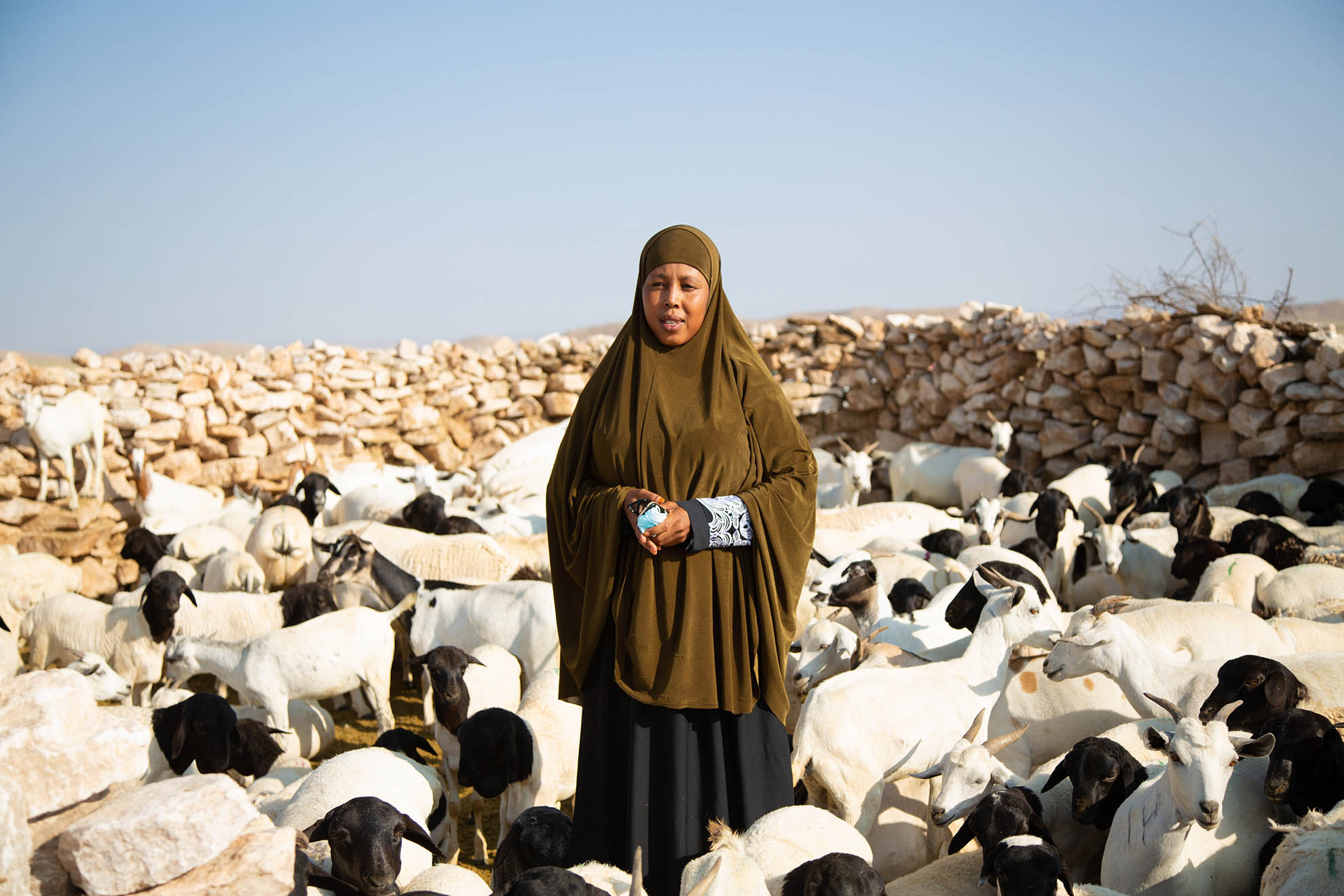



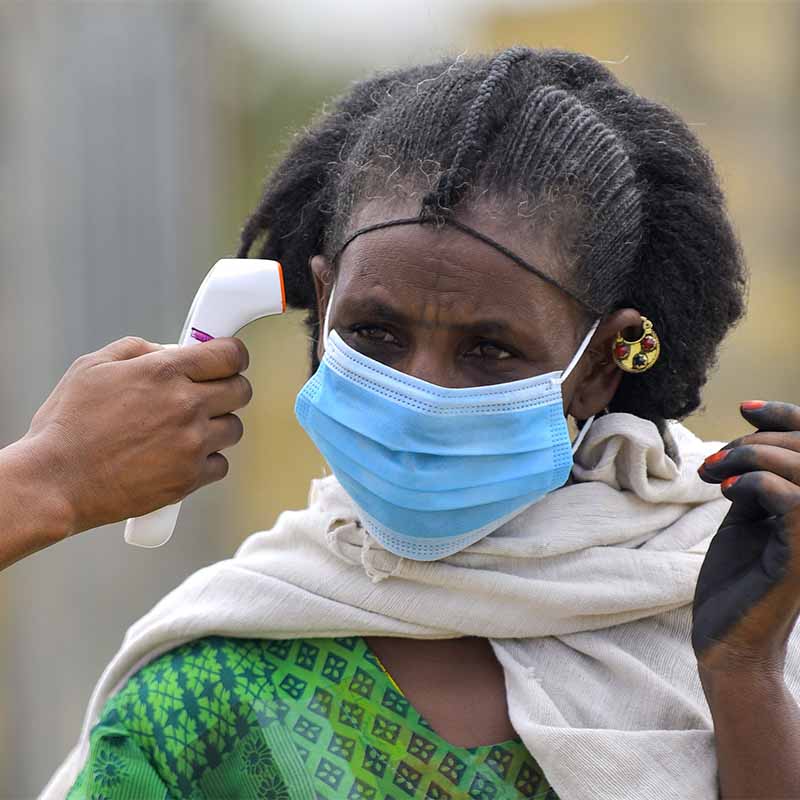


The impacts of shocks and stresses on women, and their vulnerabilities and resilience capacity, are influenced by numerous factors. These include the type of job and conditions under which women work; the informality and uncertainty that often accompany their working arrangements; the disproportionate burden of care that falls on women; the lower access of women to productive assets and services; and social norms and policies that constrain women’s empowerment and gender equality in agrifood systems. The gendered-agrifood-systems-framework presented in Chapter 1 emphasizes the different impacts both structural gender inequalities and shocks and stressors have on men and women. Women are often described as “shock absorbers” within households, in reference to the ways in which they adapt their work patterns, food consumption and even ambitions and expectations to deal with shocks.1
This chapter examines how different types of shocks and stresses, namely COVID-19, climate change, conflict and their associated economic crises, have impacted, shaped and, in many cases, further exacerbated existing inequalities. The chapter also explores the ways these shocks and stresses have affected the resilience of women and girls and their household members’ food security and nutrition. In the context of agrifood systems, resilience is defined as “the capacity over time of agrifood systems, in the face of any disruption, to sustainably ensure availability of and access to sufficient, safe and nutritious food for all, and sustain the livelihoods of agrifood-systems’ actors.”2 Increasing women’s resilience to shocks and stressors is critical to achieve improved food security and nutrition and thus Sustainable Development Goal 2 targets.
Increasing women's resilience is critical to achieve improved food security and nutrition.
Shocks and stressors rarely happen in isolation: they commonly build on each other in complex and interconnected forms, making coping strategies harder. This is particularly true in rural areas, where poverty, inequality and climate change are inextricably linked, resulting in increased vulnerabilities for people living there, particularly women and girls.3 These vulnerabilities are also driven by multiple and intersecting forms of discrimination linked to gender, age, ethnic group, health, disability and economic status.
In some cases, acute crises – such as pandemics or strong weather shocks – happen on top of chronic longer-term crises, such as those related to climate change. The response to this type of crisis often triggers and exacerbates already existing gendered differences, leading to women having even more unpaid care work, less and more difficult access to information and safety measures, increased gender-based violence, increased financial difficulties and more limited livelihood strategies.4 The combination of these mixed and multiple crises often happens in areas where gender inequality is already high; for example, countries facing high exposure to extreme climatic events are often those in which gender inequalities are significant or where poverty is widespread.6, 7, 8 Climatic stressors can also act as an indirect driver of or aggravating factor to conflict, particularly in regions dependent on agriculture and with other institutional constraining factors such as political instability and low levels of economic development.9, 10
These challenges call for interventions that focus on building resilience and adaptive capacities at social, economic and landscape level. Such interventions include gender-responsive approaches that account for the type of shocks and for the short- and long-term impacts on women’s abilities to cope with multiple, recurring shocks and stressors while also empowering them as agents of change, thus contributing to overall agrifood systems resilience.
Shocks and stresses lead to economic crises that have different impacts on men and women, on urban and rural areas and on agriculture compared with other sectors.
The COVID-19 pandemic has had more acute economic impacts on women’s participation in agrifood systems than have previous economic crises. These have included large declines in women’s employment in agrifood systems generally and in the off-farm segments of agrifood systems in particular. During the financial crises of the 1990s, for example, participation in agriculture grew, absorbing workers displaced from sectors such as manufacturing, construction or the public sector.11, 12 Women’s employment generally increased during these and previous crises, especially among poorer households and the less well educated or those working in the informal sector, playing a countercyclical role.13, 14
The impact of the 2007–2008 global economic and food-price crisis on employment in agrifood systems serves as a good point of comparison. Women globally experienced a small decline in employment in both agriculture and off-farm parts of the agrifood systems between 2007 and 2008, which was broadly comparable to the small employment losses experienced in the sector by men (Figure 5.1).15 Globally, agriculture did not act as a buffer, although there were also considerable differences across regions: Northern Africa, for example, faced the largest decline in female employment, while employment increased for both women and men in sub-Saharan Africa.
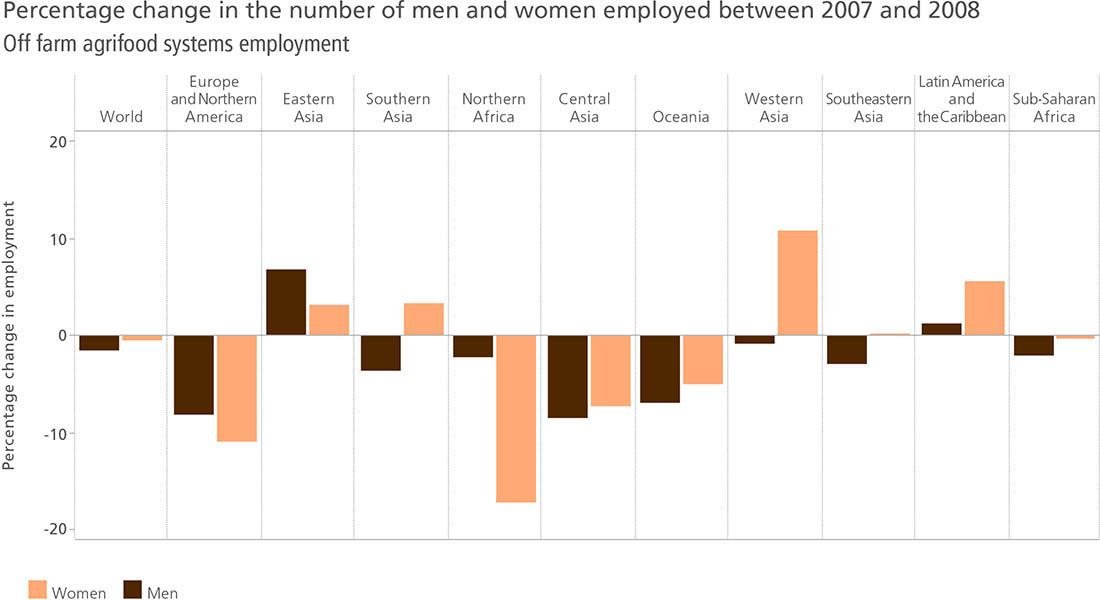
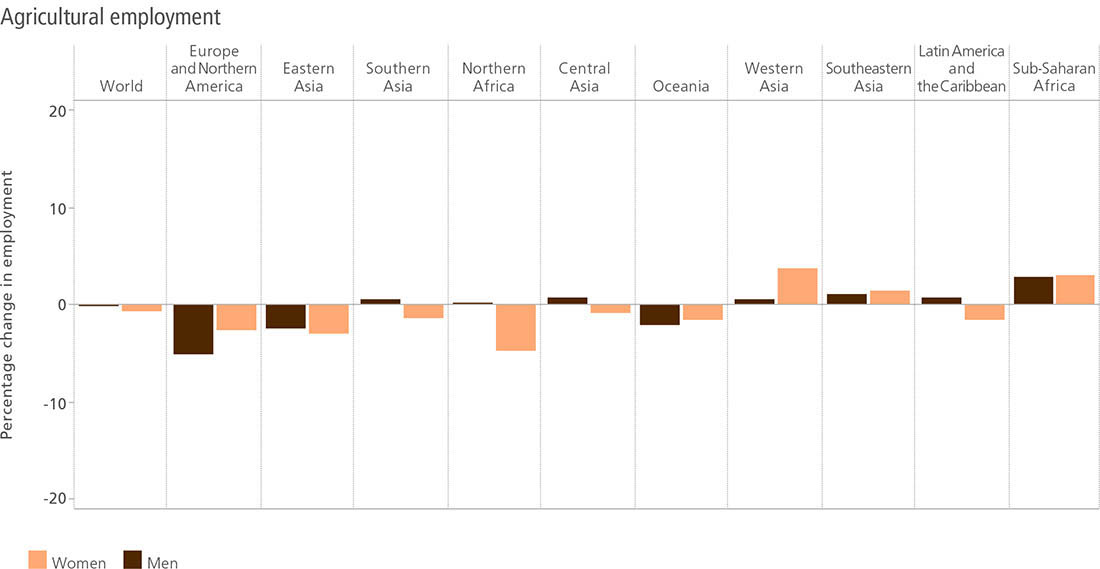
The COVID-19 pandemic exposed existing underlying gender inequalities in agrifood systems. It also worsened inequalities between men and women, particularly in employment, access to financial resources (savings, assets and access to credit) and nutritious food, access to and use of health services, the burden of care and exposure to domestic violence.16, 17
In contrast to previous crises, women working in agrifood systems during the COVID-19 pandemic experienced greater employment losses than men in the first year of the pandemic. Female employment in agrifood systems declined by 12 percent, compared with a decline of only 3 percent in male employment in agrifood systems. The drop in women’s employment was largely driven by a reduction in off-farm agrifood-system activities: 22 percent fewer women were working off-farm in agrifood systems in 2020 than in 2019, whereas men’s employment in the same sector declined only by 2 percent during the same period (Figure 5.2).18 Gender differences in employment losses were particularly stark in Southeast Asia and Latin America and the Caribbean.
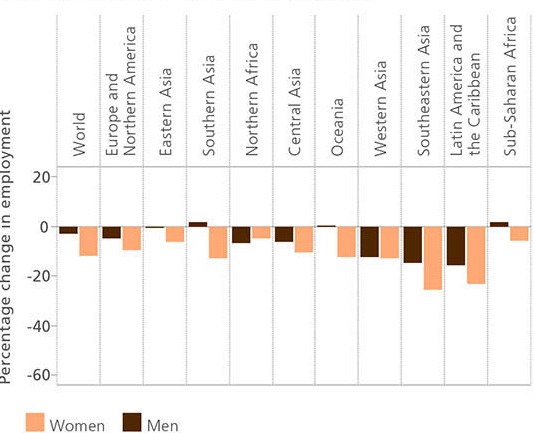
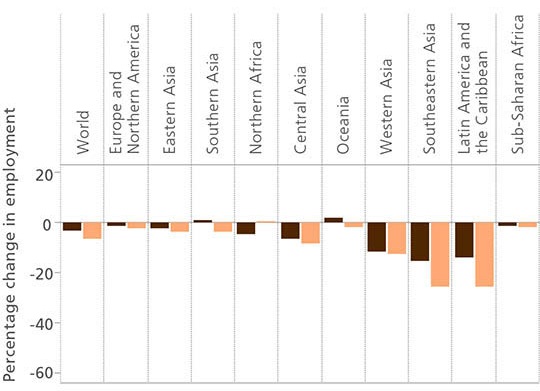

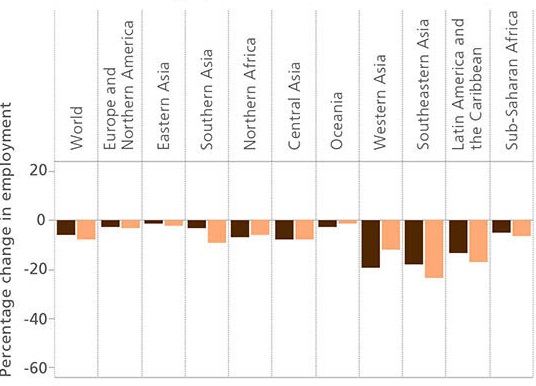
This is consistent with broader trends in the economy during the COVID-19 pandemic: women were more likely to self-report job losses than men in all regions.19 Retail, business and manufacturing industries, where 40 percent of women worked, were hit particularly hard by the pandemic20 (see Boxes 5.1 and 5.2 for country-specific examples). Women and youth were heavily impacted by the pandemic because they represent a large share of low-skilled and poorly-educated workers and, as such, are more likely to be self-employed or casual workers and thus more likely to lose their jobs and to experience income disruptions.21, 22, 23, 24
A study of the impacts of the COVID-19 pandemic found differential effects on women and men in rural households in Kenya, the Niger, Rwanda and Uganda.i
In Kenya, rural women were more likely than men to report pandemic-related income losses early in the pandemic. Women and men primarily engaged in casual labour, processing, marketing and trading activities were significantly more likely to experience pandemic-related income losses than were their counterparts employed in other sectors. Differences in income loss across different types of livelihood activities were similar in the Niger, where, however, men were more likely than women to experience income disruptions during the first year of the pandemic.
Women and men adopted different coping strategies. In Kenya, women used savings as a first coping response to deal with income losses, while both men and women sold assets and borrowed money as a coping strategy, with no significant gender differences. The primary sources of borrowing were friends and family, followed by self-help and village savings groups. Only a small share of respondents borrowed from banks, moneylenders or cooperative banks. Twenty percent of women and 10 percent of men reported using government transfers to support their needs.
In contrast, in the Niger, selling assets and reducing consumption were the first responses to deal with income loss, with no gender differences. Borrowing money remained an important strategy for men and women throughout the pandemic, with women being more likely to borrow money later during the pandemic when men generally used savings as a coping strategy more than did women. In Rwanda, the use of savings was the main coping strategy adopted by both men and women. Respondents reported less access to cash transfers, and both women and men drew down their own assets and savings. However, men were more likely than women to reduce expenditures, sell assets and seek alternative or additional employment. As the pandemic persisted, borrowing tended to increase, in particular for women, due to the depletion of savings and assets and lack of access to government or NGO transfers.
In Uganda, men were more likely to borrow as a first coping response, while women were more likely to borrow in a later phase, after the depletion of assets and savings. Most rural men and women borrowed primarily from informal sources, such as friends and neighbours or rotating savings schemes. Very few borrowed from formal sources, such as banks and microfinance organizations. Women were more likely than men to borrow from rotating savings schemes.
In Central Asia, the COVID-19 pandemic increased gender gaps in agricultural and off-farm employment, decision-making power and access to assets and finance. In Kyrgyzstan and Tajikistan, a significantly higher proportion of women than men reported a loss of income due to the pandemic (44 percent of women versus 37 percent of men in Kyrgyzstan; 28 percent of women versus 22 percent of men in Tajikistan).
Women and men relied on different coping strategies to overcome pandemic-induced shocks. Selling assets was more common among rural men than rural women because women in Central Asian countries are typically “asset poor” due to discriminatory legislation, customary laws and gendered social norms.i, ii, iii A higher proportion of women than men reported not having savings in Kyrgyzstan and Uzbekistan, leading to significantly more men than women using savings to cope with the shock (12 percent versus 6 percent in Kyrgyzstan and 22 percent versus 18 percent in Uzbekistan). In all three countries, rural women not able to reach formal financial institutions had to borrow money from an acquaintance or relatives (between 5 percent and 16 percent of women).
Moreover, rural women increased their unpaid workloads, combining agricultural activities with household chores, treating sick family members and helping children while home-schooling. The pandemic in Tajikistan resulted in a higher proportion of women than men increasing time spent caring for children (47 percent versus 34 percent) and helping them with their education (48 percent versus 38 percent). Loss of jobs and income coupled with restricted mobility resulted in tensions and aggression from family members, making rural women vulnerable to physical and emotional abuse.iv, v, vi The pandemic also led to limitations in reaching health facilities and services: a significantly higher share of women than men reported spending less time visiting health services in Kyrgyzstan (51 percent versus 40 percent) and Tajikistan (77 percent versus 68 percent).
Rural women were more strongly impacted by the pandemic than were men in terms of access to food (Figure A). The onset and subsequent spread of the COVID-19 pandemic, along with related mobility restrictions enacted by many national governments, triggered sharp increases in food prices and shortages in food supply. Income losses, disruption of jobs and business and gender-based gaps in the labour market exacerbated pre-existing decision-making gaps over income spending,vii, viii including women’s ability to buy food. This disproportionately affected female food security and women’s ability to secure adequate and healthy nutrition.
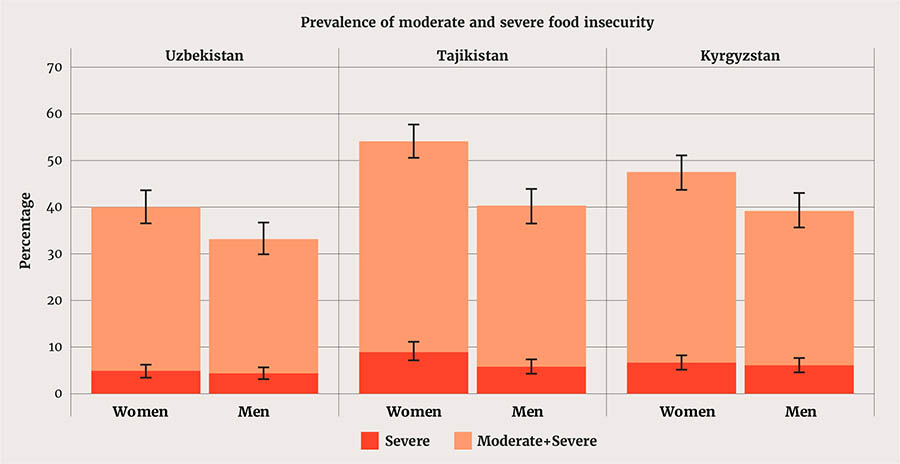

Women were more likely than men to attribute their food insecurity experience to the pandemic (81 percent versus 73 percent in Kyrgyzstan, 67 percent versus 56 percent in Tajikistan and 70 percent versus 66 percent in Uzbekistan). Similar results were seen for decreased consumption of a variety of foods: more rural women than men noted that they had started to consume less meat and meat products, eggs and dairy products, fruits, vegetables, beans, legumes and nuts as a result of the pandemic.
The pandemic also increased women’s care burden. Women’s multiple care responsibilities, combined with disruptions of services and school closures, increased female unpaid domestic care, with the ratio of women’s to men’s care burden rising from 1.8 in March 2020 to 2.4 in September 2021.19 Increased care burden exacerbates the risk of loss of employment because household chores and unpaid domestic duties force women to forgo work or reduce their working hours. About 49 percent of women reduced their paid working hours during the first year of the pandemic.25
The pandemic also caused an increase in the number of girls who dropped out of school for reasons other than school closures (girls were 1.21 times more likely to drop out of school than were boys).19 For example, in Honduras and Uganda lockdown measures increased girls’ domestic and care burden and disproportionally decreased their school attendance compared with boys.26 When girls leave school, it can be very difficult for them to resume their studies.27
The COVID-19 pandemic increased food insecurity globally, but the impact on women was especially acute, leading to a widening gap between men’s and women’s food insecurity. As reported in Chapter 1, the gap grew from 1.7 percentage points prior to the pandemic in 2019 to 3 percentage points during the first year of the pandemic26 and reached 4.3 percentage points in 2021.
The causes of this increasing gender gap in food insecurity are varied. The reduction in women’s food production and distribution capacities reduced their purchasing power and lowered their access to nutritious food.28 Pandemic-related income losses increased work burdens, while rising food prices induced a shift towards fewer and cheaper calories, with implications for food security and nutrition. In some countries and contexts, women and girls were more likely than men and boys to reduce the frequency and quality of food intake as a result of sociocultural values and practices that underpin gender inequalities within households.26, 29, 30
Incidence and perceptions of gender-based violence, especially domestic violence and abuse against women and girls, soared during the COVID-19 pandemic, largely as a result of intrahousehold tensions during lockdowns, school closures and food and financial insecurity.31, 32 The first indications of rises in gender-based violence were visible in increased outreach to hotlines for violence survivors, to police and to domestic violence crisis units in hospitals.33 Stay-at-home orders may have increased exposure to potential perpetrators while at the same time restricting movement and access to support services.34 Additional factors, such as age, socioeconomic status, ethnicity and disability, also interact with vulnerability to and experience of violence during pandemics.35
Globally, households adopted a variety of strategies to cope with pandemic-induced shocks. Coping strategies depended on pre-pandemic resilience capacities, such as financial resources and social and human capital (see boxes 5.1 and 5.2). Resilience capacities to the economic impacts of the COVID-19 pandemic are shaped by gender inequalities. In addition to gender differences, coping capacity and responses also vary by food environment (rural versus urban) and by type of agrifood value chain. Rural women and girls, who are more likely to be engaged in informal employment and have less access to productive resources, social assistance and support services, may be forced into further dependence on male partners.35 Coupled with food insecurity and restricted movement, the consequent loss of bargaining power may have forced women to adopt negative coping strategies, such as engaging in transactional sex, or exposed them to other forms of sexual exploitation. 34, 35
Globally, social protection programmes were a key response to the COVID-19 pandemic. However, by July 2021 only approximately 20 percent of all social protection and labour-market measures related to the COVID-19 pandemic worldwide accounted for gender. Promising gender-responsive social protection approaches adopted by governments focused mainly on informal employment, mitigating gender-based violence and addressing the unequal distribution of care work.35
Economic sectors highly exposed to and dependent on weather and climatic conditions, such as agriculture, are strongly affected by climate change and climate-related shocks.3 Climate change also affects food supply chains and other components of agrifood systems, impacting dietary, environmental, socioeconomic and livelihoods outcomes.37 As such, the effects of climate change hamper poverty reduction efforts and undermine progress made on food security and nutrition worldwide. Local conditions, exposure to climate risk and the degree to which a rural household or individual is affected by exposure to climate risk create differing degrees of climate-change impacts within countries and societies.
Adaptive capacity – the ability of an individual, household or community to develop resilience and adjust to climate risks – determines the level of vulnerability to climate change, which is not homogeneous within communities and differs by gender and other intersecting social categories such as class, socioeconomic status, ethnic group and education.3, 38, 39 Increasing adaptive capacity reduces sensitivity to climate change and makes the individual, household or community less vulnerable to its impacts. Adaptive capacity is influenced by access to, availability of and capacity to use resources, including financial, technical, educational, social and natural resources. As such, climate change is interrelated with global patterns of inequality: the poor and the most vulnerable sectors of society, who have a lower capacity to cope with economic and environmental shocks and stressors, suffer disproportionally from climate-change-related impacts.8, 37, 40, 41
Climate change impacts men and women differently.3 As the next sections will show, gender disparities exist in terms of sensitivity to climatic stressors and shocks which, combined with exposure, determine the level of impact. In turn disparities in adaptive capacities and climate-response preferences determine different levels of vulnerability and welfare outcomes.38 These disparities are context-specific and influence the ability of women and men across age, class, ethnicity and other social dimensions to exercise agency in climate-response preferences at different levels.42 Unlike the other largely unanticipated shocks discussed in this chapter (the COVID-19 pandemic and conflicts), climate change poses particular challenges associated with both slow onset changes and acute shocks. As such, it requires gender-responsive anticipatory governance to manage climate crises ex ante.
The extent to which people are exposed to climatic stressors and shocks and whether they are or could be negatively affected by this exposure are influenced by gender, among other things. Rural women and men’s differentiated livelihood roles, responsibilities and rights, largely shaped by gender norms and social structures, influence the nature of their climate risk sensitivity.38 For each location, this gendered heterogeneity in exposure and sensitivity to climatic stressors and shocks also intersects with other forms of social differentiation such as class, age or disability status,40, 42 affecting adaptive capacity and therefore level of vulnerability.
Poverty, marginalization and discrimination of ethnic minorities, Indigenous Peoples and low-income women – who are highly dependent on agrifood systems for livelihoods (see Chapter 2) – tend to make these groups more vulnerable to food insecurity and malnutrition resulting from climate-change impacts.3 The context-specificity of such gendered impacts and the intersecting factors influencing vulnerabilities is key towards identifying the specific groups of men and women that might become more at risk from specific climatic stressors and shocks.42 Geospatial systems, mapping approaches and other index-based methodologies show potential for identifying climate-risks hotspots and climate vulnerability of different groups of men and women within agrifood systems, thus permitting more targeted gendered climate-adaptation planning and interventions.5, 43, 44, 45
Climate change inflicts significative negative impacts on agrifood systems by, for example, reducing agricultural productivity and disrupting food supply chains. As such, it reduces the livelihoods of a high proportion of women living in low- and middle-income countries whose employment is directly dependent on agrifood systems (see Chapter 2).
The nature of gendered climate-risk exposure varies by context, such as rural or urban, poor or rich.41, 40 For example, in low- and middle-income countries, rural women, who are generally responsible for water collection (Chapter 2), may have a disproportionate exposure and sensitivity to changes in water availability exacerbated by climate change.46, 47 Vulnerable urban households may experience more harm from flooding and associated health risks (e.g. cholera, diarrhoea) than rural households because of poor water infrastructure and the crowded conditions they live in, and these impacts have a disproportionate effect on urban women.48
Mortality following extreme weather events and natural disasters shows clear gendered patterns. Women – particularly those with lower socioeconomic status, with limited agency and poor access to information – often have less access to relief and assistance, lower survival rates and reduced life expectancy following natural disasters than men.49, 50, 51, 52 In South Asia and Southeast Asia, cultural norms limiting rural women’s ability to swim or climb trees have been linked to lower survival rates of women during floods.53, 54 Similarly, in South Asia, the practice of purdah, which limits the extent to which women can contribute to socioeconomic activities outside their homesteads, has been linked to greater vulnerability and higher mortality of women following natural disasters. This may be because women might not be able to participate in evacuation planning or might be hesitant to leave their house to seek shelter before disasters hit.55, 56
Mortality following heat stress also differs between women and men, although data on this topic remain strongly focused on high-income countries, with fewer studies on low- and middle-income countries. Several countries in Europe have reported higher heat-stress-related mortality for women than for men, particularly among the elderly,57, 58, 59 while higher natural heat-stress-related deaths among males have been reported in the USA.60 There are also clear links between exposure to heat stress and other extreme events and gender-based violence,61, 62 which can further increase morbidity and mortality risks for women. For example, heat waves in Spain increased reported intimate partner violence, femicides and calls to helplines, probably because of increased irritability and stress, which lowered the threshold for perpetrating violence.63
Vulnerability to the impacts of climate change is inextricably linked to adaptive capacity.64 Adaptive capacity in turn is determined and shaped by a range of socioeconomic and institutional factors, with gender inequality playing a key role, particularly in areas most exposed to climate risks. The connection and intersections between gender inequality and adaptive capacity range from uneven access to resources, education and institutions to cultural norms and existing social structures.41
Men and women also exhibit differing preferences and choices for how to adapt to the negative impacts of climate change.65 Choices of adaptation practices tend to partly reflect gender differences in roles and responsibilities, with men and women tending to favour the adoption of practices that directly impact their livelihoods and operations.66, 67 Despite women’s crucial role in the adoption of climate-resilience strategies,3 their limited agency constitutes a key constraint to advocating, negotiating and exerting power over their preferred climate-adaptation strategies and choices at different levels (household, community, group, organization and policy).3
Women and men differ in their access to the productive inputs and technologies needed to adapt to climate change. Given that women’s labour burden is increasing with climate change in some contexts, access to labour-saving technologies and tools is of particular importance to improving the well-being of women.68, 69, 70 In East Africa, the level of resource constraint women face can limit the use of such technology, even when women have an interest and willingness to adopt climate-smart technologies.71, 72 Gender norms may also affect the ability of women to access or adopt certain technologies that are not considered appropriate for the local context.73 For example, gender norms may limit women’s ability to adopt climate-smart solutions74 such as conservation agriculture75 or agroforestry76 or may restrict women’s access to and ability to use fertilizers or improved seeds.77, 78 They may also prevent women from adopting newer productive technologies or energy-saving technologies in food processing and transformation, all of which can prove key for climate-change adaptation. At the same time, in many contexts rural women play a central role in crop seed selection and conservation of traditional varieties and crop wild relatives, thus contributing to the maintenance of a wide genetic base for crop production that can prove fundamental for climate-change adaptation.79
Access to services (both financial and advisory) and information is important for climate-change adaptation. Discriminatory gender norms tend to limit women’s mobility and their ability to access extension services and climate information, to engage in income-earning opportunities and to join and participate in groups and local organizations, all of which are important to climate resilience.46, 68, 80 In Africa the major barrier to adoption of agroforestry practices is a lack of access to information, and women farmers and woman-headed households face particular difficulty in accessing such information.81 Additionally, women may have different preferences to those of men for the types of climate information services and weather index insurances products that they receive.82, 83 When women’s preferences are not considered in the design of climate-smart agriculture extension services, the services run the risk of reducing participation by women and limiting knowledge-sharing.84 The gender gap in mobile phone ownership (see Chapter 3) can also limit women’s ability to access climate and weather information.85 Women also have less access than men to financial services (see Chapter 3). In Guatemala and Honduras, for example, women have less access to agricultural credit and loans from formal financial institutions than men, even though women are more likely to invest in climate-change-adaptation strategies.86 There are also substantial gender gaps in the access to, use of and demand for agricultural insurance.87 Gender norms limiting women’s mobility and access to land documentation can negatively influence their ability to take out weather-index-based insurance.88
Women and men differ in their access to the productive inputs and technologies needed to adapt to climate change.
Social capital is fundamental for the resilience capacities of female and male farmers. Membership in community-based organizations and the ability to participate in their activities can enhance adoption of climate-smart agricultural technologies.89 Social networks and groups have been shown to be important sources of climate information, resources and economic opportunities for women and to contribute to their capacity development and increased agency.39 In some contexts, men tend to have wider social networks (see Chapter 3) and greater participation in community decision-making, which in turn can influence adaptive behaviour.67
Likewise, human capital is fundamental for climate resilience. People with better education, knowledge and skills tend to adopt new technologies, to have a more diversified livelihood portfolio and to have better access to services.90 Climate change can affect girls’ education more than boys’38, 91 and supporting girls’ education, reproductive rights and life skills could lead to improved climate resilience.92 For example, in Malawi, school feeding programmes have been shown to reduce the probability that girls are withdrawn from school when droughts occur.93
The ways in which women, men and households cope with climate shocks, for example by reducing food consumption, selling assets, migrating or adjusting labour allocation, have important implications for women’s well-being and future resilience46, 94 Rural women, who have limited resilience capacity and consequently restricted options to respond to changes in climate, often have to resort to short-term coping strategies at the expense of their long-term resilience to climate shocks and stressors.46, 95, 96, 97, 98 In India, for example, women often resort to decreasing the number and size of meals they consume during droughts, with negative effects to their overall health.99 In Uganda, husbands’ assets are better protected against weather shocks than those of their wives, with some indication that households affected by flood may be disposing of wives’ non-land assets as a coping mechanism.100 Women whose husbands have migrated due to climate change and other economic constraints may face additional work burden101 or increased mortality risks.102
Decisions to alter labour allocation in response to climate change also have different outcomes on men and women in terms of relative labour burden. Households may alter labour patterns in response to heat stress in ways that increase women’s work burden in agriculture. In the United Republic of Tanzania, for example, heat stress was associated with reductions in family agricultural labour by men but did not affect family agricultural labour by women in households with both men and women present and was associated with increases in family agricultural labour by women in female-only households.103 A recent study from Africa104 demonstrated that, while both heat waves and droughts are correlated with reduced hours worked in agriculture, this impact is 40 percent lower if the farmer is female. Thus, the portion of hours worked by women in agriculture during extreme heat and drought increased relative to those worked by men, suggesting that women suffer disproportionally from weather-related shocks by maintaining working levels despite the impacts of the weather. Older girls may also face a greater risk of being pulled out from school than do older boys when the demand for family labour increases as a consequence of climate shocks, with long-term consequences for their well-being.98, 105, 106
Short-term strategies to cope with climate change may also drive women and households to adopt maladaptive practices, such as practices that may degrade natural resources, or to adopt negative coping mechanisms, such as engaging in transactional sex, including for aid.62, 107 Extreme weather also contributes to increases in early and forced marriages (see also Box 5.3 on potential impacts on child labor). In Bangladesh, for example, women and girls are more likely to be married early or forced to marry in the year of or after moderate to severe heat waves and are more likely to marry men with less education and who were more supportive of intimate partner violence.108 During such extreme weather events, families may be more willing to accept less-desirable marriages (i.e. marriages into poorer households and to less-educated husbands) to ease financial burden, reduce dowries or bring forward a marriage, thus exposing women to morbidity and mortality risks that endure beyond weather events.108
The increasing frequency and intensity of extreme weather events resulting from climate change affect the living conditions and livelihoods of millions of people, including vulnerable children. Moreover, boys and girls may be affected differently by climate-related events given gender differences in domestic and work activities and care burden.
A recent study in Côte d’Ivoire, Ethiopia, Nepal and Peru found differences, but no consistent patterns, between genders and countries in the effects of dry spells and heavy rains on children’s work, both in terms of incidence and intensity (time worked). In Côte d’Ivoire, heavy rains are associated with a lower incidence of work for boys but an increased incidence of work for girls. Conversely, dry spells lead to an increased intensity of work for boys but not for girls. In Ethiopia, heavy rains are more likely to increase the incidence and intensity of work for boys, while there is no evidence of effects of dry spells on work by boys or girls. In Nepal, heavy rains are associated with a reduced intensity of work for girls but not for boys. In contrast, dry spells are associated with an increase in the incidence of work for girls but a decrease in the incidence and intensity of work for boys. In Peru, the results show no evidence of an association between independently verified heavy rains or dry spells and children’s work. However, an additional analysis found an association between self-reported dry spells and an increase in the incidence and intensity of work for boys but not for girls.
While it is evident that the work burden of boys and girls is affected differently by climate-related events, the lack of a consistent pattern by gender or event suggests the importance of taking a closer look at the underlying mechanisms and in particular the link between climate-related shocks, child work and care burden.
Overcoming gender inequality is a key and indispensable step in climate-resilient development. Addressing climate-change issues and achieving climate-adaptation and mitigation objectives must be done in a way that not only avoids further gender imbalances but purposively aims at reducing vulnerability and enhancing women’s empowerment.41
Building the resilience of agrifood systems is vital, given the increasing rates of hunger and food insecurity in recent years, particularly in countries affected by conflict (see Box 5.5).2 Food insecurity, malnutrition and undernutrition are all increasingly concentrated in settings affected by armed conflict.109 Conflicts and instability have been a major driver of the increasing prevalence of hunger, particularly in the Near East and North Africa since 2012.110 Globally, conflict and insecurity remain the main drivers of food crises in terms of the number of people affected.111 In 2021, around 139 million people were facing a crisis or worse (Integrated Food Security Phase Classification-Cadre Harmonisé [IPC/CH] Phase 3 or above112) across 24 countries or territories where conflict or insecurity was considered the primary driver.113 Conflicts were the main driver in three of the four countries with populations in catastrophe (IPC Phase 5) – Ethiopia, South Sudan and Yemen. By 2030, two-thirds of the global poor will be living in states classified as either fragile or in conflict; poverty is either stagnant or rising in these states.114
The COVID-19 pandemic had caused increasing food insecurity in Ukraine before the outbreak of the war. Moderate or severe food insecurity among women increased from 17.3 percent in 2019 to 28.9 percent in 2021; among men it increased from 13.3 percent to 24.0 percent over the same period (Figure A). While the differences between women and men are not statistically significant, the pattern suggests that women have been more food insecure than men since at least 2014.
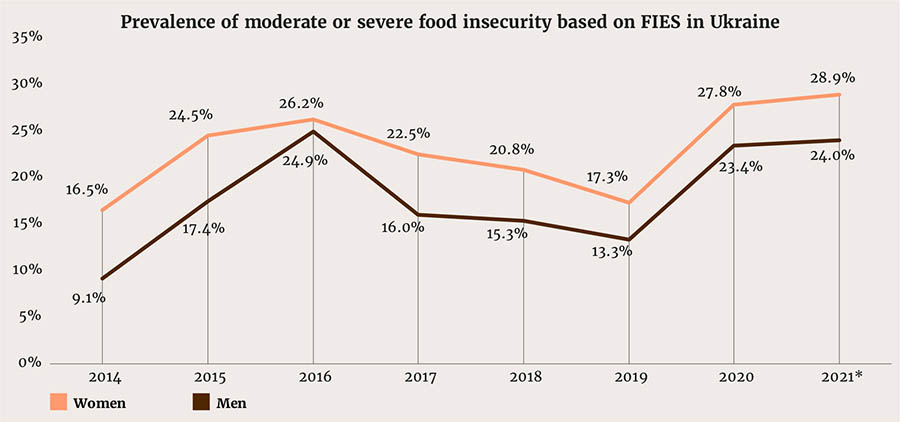
Gender intersects with other social dimensions affecting the vulnerabilities of distinct groups, including the Roma population, people living with disabilities, women in rural communities, in displacement and conflict zones, and LGBTI+ communities.i The war in Ukraine and its impact on agricultural production and trade and other aspects of life have caused significant changes in the sex and age patterns of mortality and (out)migration, with important consequences for gender equality, family dynamics and social relations.i
Violent conflict has been defined as the “systematic breakdown of the social contract resulting from and/or leading to changes in social norms, which involves mass violence instigated through collective action.”i The OECD uses several criteria to define which instances of violence amount to “conflict”.ii They include the nature of the violence; the number of fatalities; the type of actors involved; and their level of organization. International humanitarian law distinguishes international armed conflicts between states, using armed force, and non-international armed conflict where hostilities reach “a minimum level of intensity” and parties demonstrate “a minimum” of organization. The Uppsala University Conflict Data Program defines armed conflict as the use of armed force between organized groups resulting in at least 25 battle-related deaths in one calendar year and differentiates state-based from non-state-based armed conflict depending on whether the government or the state is involved.iii The Armed Conflict Location & Event Data Project, data from which is presented in this chapter, does not define what a “conflict” is but defines six political disorders and event types and 25 subevent types.iv
IPC/CH data are not sex-disaggregated, but evidence shows that women are often more vulnerable to food insecurity as they continue to face additional risks, barriers and disadvantages due to their gender.115 Conflicts and peacebuilding, food security and nutrition, and gender equality are interlinked, with causal relations in both directions.116 Violent conflicts have specific gender-differentiated impacts in terms of nutrition, food security, gender-based violence (see Box 5.6), health and economic outcomes, educational outcomes, mobility and political and civic activities.117, 118, 119, 120 In some cases, armed conflicts have a greater effect on women and girls than on men and boys, particularly in terms of sexual violence, malnutrition and not returning to school. In other cases, men and boys suffer more in terms of conflict-related deaths and injuries, abduction and recruitment to armed groups, and job and education losses.
Gender-based violence (GBV) manifests in many ways during crises. Prior conditions are often aggravated during crises, while new forms of violence may emerge.i For example, eight forms of GBV were identified during armed conflict in Uganda: physical, sexual and economic violence; quarrelling; early marriage; land grabbing; poor family relations; and failure to disclose HIV status.ii In Colombia, additional forms of GBV included threats of violence against family, forced recruitment, forced abortion or reproductive control, abduction, rape and trafficking.iii Estimating the nature and magnitude of sexual and gender-based violence in conflict and post-conflict contexts is difficult because of the different types of violence, stigma associated with victimization and breakdowns of legal frameworks and social services that occur during these events.iv, v, vi Multiple forms of violence may overlap and exacerbate vulnerability to or experience of violence. Individuals’ characteristics, such as being widowed or orphaned or having low socioeconomic status, interact with gender inequalities affecting the risks of GBV.
In conflict settings, sexual violence is at times employed as a tool to torture and terrorize people.vii, viii The term “conflict-related sexual violence” refers to rape, sexual slavery, forced marriage, prostitution, pregnancy, abortion and sterilization, and any other form of sexual violence of comparable gravity perpetrated against women, men, girls or boys that is directly or indirectly linked to a conflict.viii Women and girls are often the most affected by violence; in 2021 some 97 percent of all reported conflict-related sexual violence was against women and girls. The true magnitude of violence, however, remains underreported.ix
Conflicts can have detrimental effects on people whose livelihoods rely on agrifood systems. While urban areas have often been considered as the principal space for violence and conflicts due to their greater population density, conflicts are becoming more ruralized in North and West Africa, despite the rapid growth of urban populations.121, 122 For example, 53 percent of the violent events observed in 2021 took place in rural areas, compared with 20 percent a decade ago.122 This ruralization of conflicts poses serious threats for empowerment of rural women and girls and their role in agrifood systems, although evidence remains limited.
The current war in Ukraine poses gendered risks on women, men and children and is predicted to become the largest humanitarian emergency in Europe since the Second World War (Box 5.4).123 It also has implications for global food security as the Russian Federation and Ukraine are among the most important producers and exporters of wheat, maize and sunflower seeds and oil.124 The conflict is likely to have gendered implications through several pathways: i) rising food prices may affect affordability of healthy diets differently for women and men; ii) rising costs of agricultural inputs might affect productivity of women and men farmers differently; iii) strained government budgets (especially following the COVID-19 pandemic) may further reduce already limited support to rural farming communities, and especially women; and iv) the lack of international collaboration may reduce official development assistance to vulnerable groups.38, 124 As such, it is important to focus on women and girls to ease the impacts of the war.
Country case studies suggest that conflict has complex implications on women’s economic roles in the household, community and broader society.117, 120, 125, 126, 127 Studies from Bosnia and Herzegovina, Colombia, Nepal, Tajikistan and Timor-Leste show that armed conflict can increase women’s participation in economic activities and labour markets;118 in some cases, this is associated with increases in overall household and community welfare.120 Agriculture is sometimes seen as “spoils of war”, where higher potential gains from agricultural production increase risks of social instability and violence. In other contexts it is described as a source of grievances and frustrations stemming from low productivity or a lack of economic opportunities that can feed into these risks.128
Table 5.1 summarizes the results of a series of regression estimates showing the relationship between labour outcomes, exposure to conflict in the past 12 months, gender and the interaction between gender and conflict exposure in 29 countries in sub-Saharan Africa.128 Women are less likely than men to participate in the labour force overall and less likely to be in the labour force after conflict exposure than are men (columns 2 and 3). Conflicts reduce work intensity for both women and men, but the reductions are greater for men than women (Figure 5.3). Exposure to conflicts may lead to greater participation in agriculture for both women and men, but the increase is greater for women than for men (12.9 percentage points versus 8.3 percentage points). Exposure to conflicts also leads to a reduction in income for women but has no impact on men’s income, suggesting that the existing wage gaps that disadvantage women are even greater in the presence of conflicts.
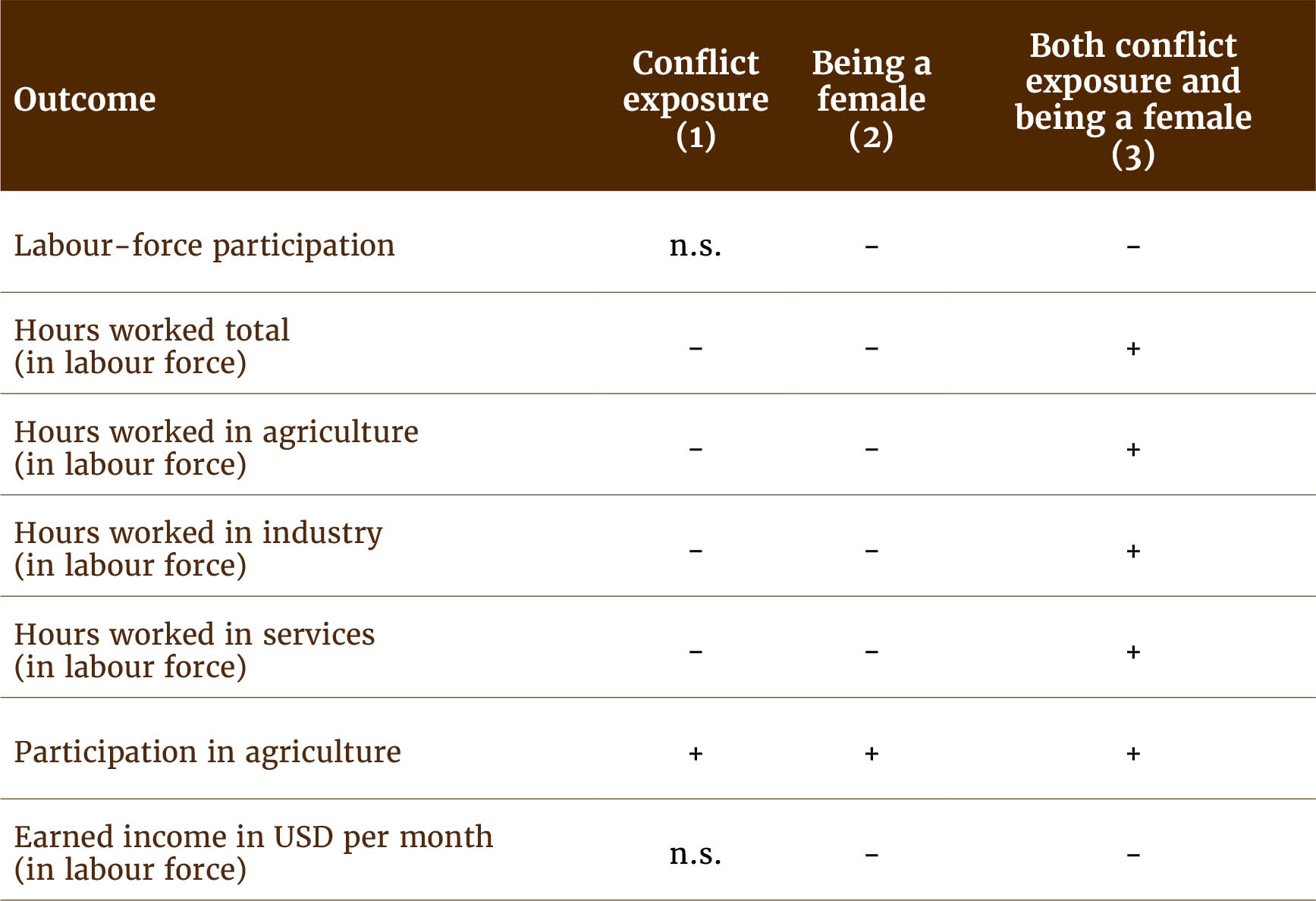
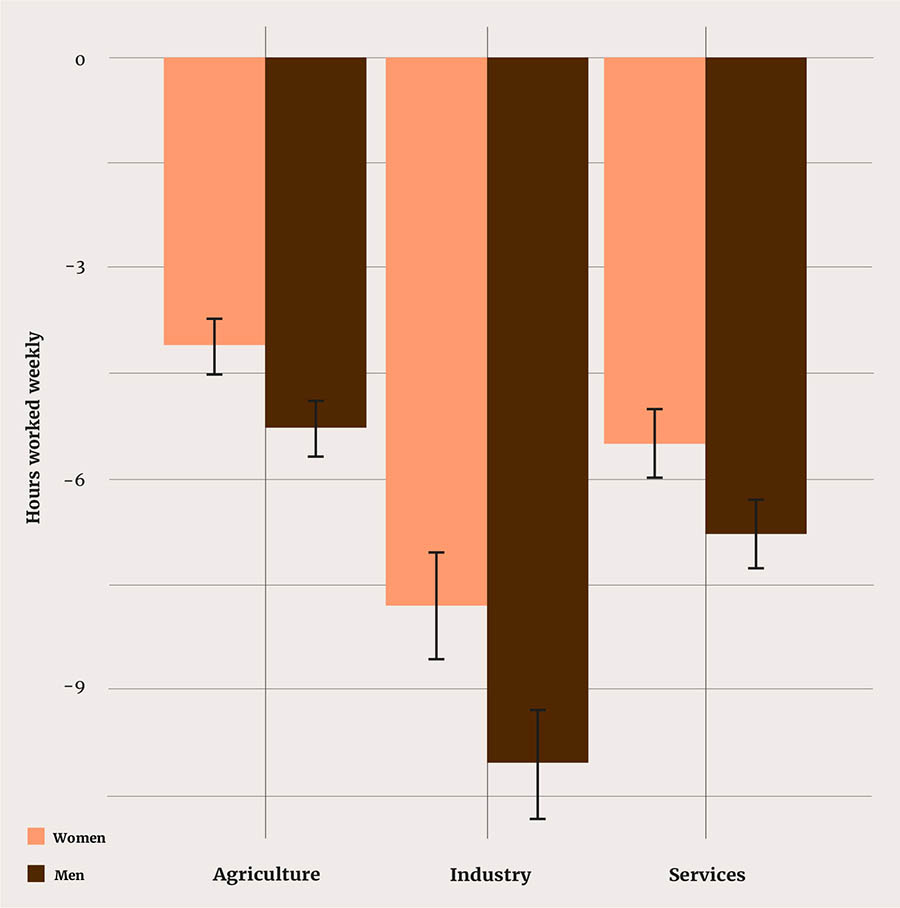
While the novel findings described above focus on Africa, the evidence for gender differences in impacts of conflicts on employment in agrifood systems in the rest of the world is mixed and particularly limited. A recent study in Colombia over the 1994–2014 period found that high-intensity armed conflict increased the unemployment rate by about 3.9 to 4.3 percentage points, with a greater effect on women than on men, which probably reflects changes in household dynamics among conflict-affected households.129 In contrast, a study in several Asian cities showed that more women joined the labour force and became breadwinners as a result of changing social attitudes or loss of male family members during conflict.130 However, given their limited skills and business experience, women were mostly absorbed in the labour market as informal workers on low pay and often were not allowed to work in male-dominated sectors such as trade and transport. Moreover, women’s new roles were extremely challenging in terms of security, hazardous working conditions and wage exploitation.130
